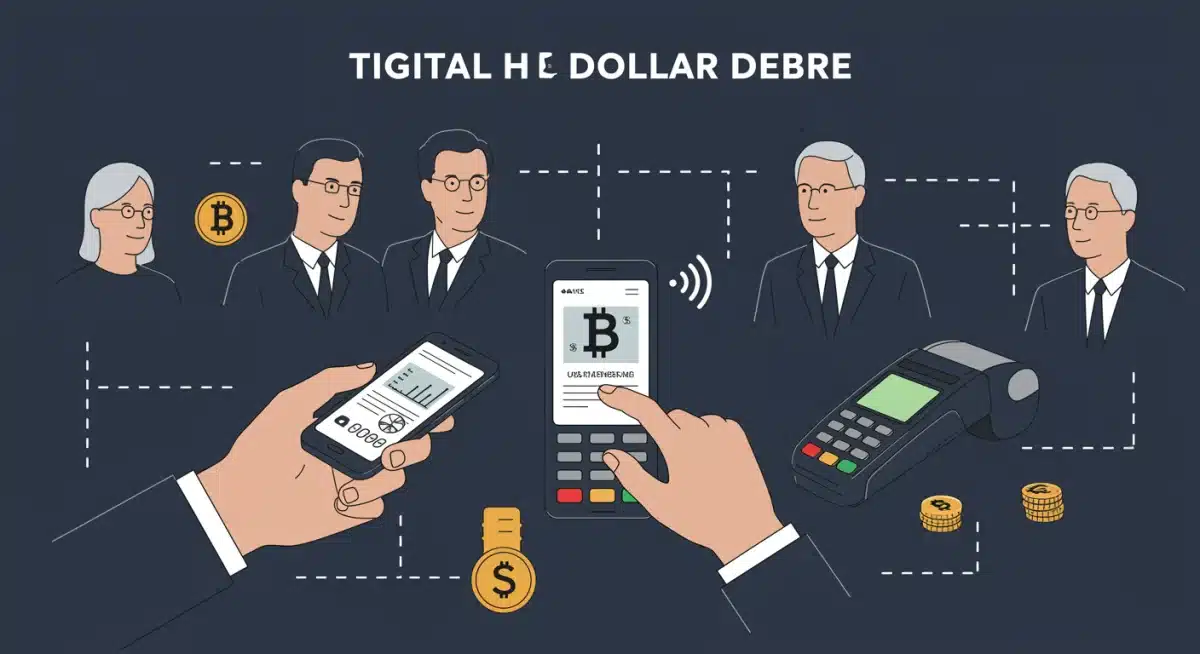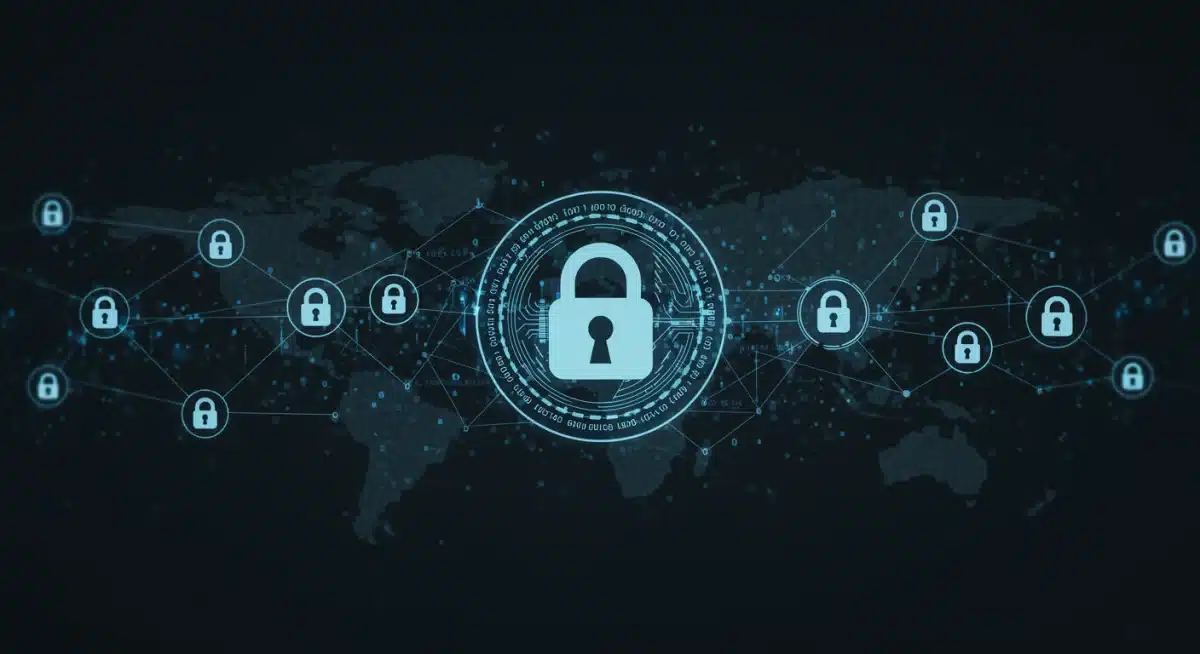Digital Dollar Debate 2025: Practical Guide for US Consumers & Businesses

This guide offers practical solutions for U.S. consumers and businesses to effectively navigate the ongoing 2025 digital dollar debate, focusing on potential impacts, privacy considerations, and economic implications.
As the conversation around a U.S. Central Bank Digital Currency (CBDC) intensifies, Navigating the 2025 Digital Dollar Debate: A Practical Guide for U.S. Consumers and Businesses (PRACTICAL SOLUTIONS) becomes increasingly critical. This developing story is shaping the future of finance, with new details emerging almost daily from policymakers, economists, and industry leaders. Understanding the nuances of this debate is paramount for anyone operating within the U.S. economy, from individual consumers managing their daily finances to businesses strategizing for future growth.
Understanding the Digital Dollar: What it is and What it Isn’t
The concept of a digital dollar, often referred to as a CBDC, is a central bank-issued digital currency designed to complement, rather than replace, physical cash and existing digital money. Unlike cryptocurrencies such as Bitcoin, which are decentralized, a digital dollar would be centralized and issued by the Federal Reserve, backed by the full faith and credit of the U.S. government.
This distinction is crucial for consumers and businesses alike. It signifies a fundamental difference in stability, regulation, and underlying trust. The Federal Reserve views a potential digital dollar as a means to enhance financial innovation, improve payment efficiency, and ensure the U.S. maintains its leadership in the global financial system. However, the exact design and implementation remain subjects of vigorous debate, influencing how it would practically function in the hands of the public.
Key Characteristics of a CBDC
- Centralized Issuance: Issued and backed by the Federal Reserve, providing stability.
- Legal Tender: Expected to be legal tender, accepted for all debts, public and private.
- Programmability Potential: Could be designed with features for specific uses, though this is a contentious point.
- Interoperability: Designed to work seamlessly with existing financial infrastructure.
For consumers, a digital dollar could mean instant payments, potentially lower transaction fees, and greater financial inclusion for the unbanked. Businesses might benefit from faster settlement times and reduced operational costs. However, these potential advantages are weighed against concerns about privacy, government surveillance, and the potential impact on commercial banks. The ongoing debate around digital dollar debate 2025 focuses heavily on balancing these benefits and risks.
The core of the discussion revolves around how a digital dollar would be structured: whether it would be account-based, similar to traditional bank accounts, or token-based, more akin to digital cash. Each model presents different implications for privacy, accessibility, and the role of intermediaries. As the Federal Reserve continues its research and public engagement, these design choices will significantly shape the future financial landscape for all U.S. economic participants.
Privacy Concerns and Data Security in a Digital Dollar Future
One of the most significant points of contention in the digital dollar debate 2025 centers on privacy and data security. The idea of a government-issued digital currency raises questions about how transactional data would be collected, stored, and utilized. For many, the prospect of the government having access to detailed records of every financial transaction is a major concern, prompting calls for robust privacy protections.
Advocates for a digital dollar argue that privacy could be built into its design, perhaps through anonymized transactions or a tiered system where smaller transactions have greater privacy. However, the tension between privacy and anti-money laundering (AML) and counter-terrorist financing (CTF) regulations is undeniable. Striking the right balance will be crucial for public acceptance and trust.
Safeguarding User Data
- Anonymity Features: Exploring designs that allow for varying degrees of privacy, similar to cash for small transactions.
- Data Minimization: Limiting the collection of personal data to only what is strictly necessary for system functionality and regulatory compliance.
- Robust Encryption: Implementing advanced cryptographic techniques to protect transaction data from unauthorized access.
- Legal Frameworks: Establishing clear laws and regulations that define data access, usage, and retention policies.
For businesses, data security with a digital dollar would involve adapting existing systems to handle a new form of currency while ensuring compliance with stringent data protection standards. This could necessitate significant investments in cybersecurity infrastructure and staff training. Consumers, on the other hand, would need assurances that their financial activities are not subject to unwarranted scrutiny or potential data breaches. The ongoing dialogue emphasizes the need for transparency and public input in crafting these privacy protocols.
The Federal Reserve has acknowledged these concerns, stating that any digital dollar would need to uphold American values, including privacy. However, the technical implementation of such protections, especially in a system designed for broad accessibility and regulatory oversight, remains a complex challenge. How these privacy issues are addressed will significantly influence the adoption and success of a U.S. CBDC.

Economic Impact and Financial Stability Considerations
The potential economic ramifications of a digital dollar are vast and complex, touching upon everything from monetary policy to the stability of the banking sector. Economists and policymakers are carefully analyzing how a CBDC could influence inflation, interest rates, and the overall supply of money in the U.S. economy. The Federal Reserve’s primary mandate is maintaining financial stability, and any move towards a digital dollar must align with this objective.
One major concern is the potential for disintermediation of commercial banks. If consumers and businesses can hold digital dollars directly with the Federal Reserve, it could reduce deposits in traditional banks, impacting their lending capacity and profitability. This could lead to a significant restructuring of the financial sector, with profound implications for how credit is extended and how capital flows through the economy.
Potential Economic Shifts
- Monetary Policy Tools: A digital dollar could offer new avenues for implementing monetary policy, though the specifics are still being explored.
- Financial Inclusion: Potentially provide access to digital payments for the unbanked and underbanked populations.
- International Competitiveness: Strengthen the dollar’s role in the global financial system amidst the rise of other nations’ CBDCs.
- Payment System Innovation: Foster new payment services and technologies within the private sector.
For businesses, the economic impact could be a double-edged sword. While faster, cheaper payments might boost efficiency, changes in the banking landscape could affect access to credit or the cost of borrowing. For consumers, the stability and convenience of a digital dollar could be appealing, but they might also face new choices in how they manage their financial assets. The digital dollar debate 2025 is fundamentally about understanding and mitigating these potential disruptions while harnessing the benefits.
The Federal Reserve has emphasized that a digital dollar would be designed to complement the existing financial system, not disrupt it. This suggests a careful, phased approach, with extensive testing and public consultation. The goal is to ensure that any implementation strengthens the U.S. economy without undermining the vital role of commercial banks or creating undue financial risks. The path forward will require careful navigation of these intricate economic considerations.
Practical Solutions for Businesses Adapting to Digital Currency
As the prospect of a digital dollar looms, U.S. businesses must begin considering practical solutions to adapt their operations. This proactive approach will ensure they are well-positioned regardless of the specific outcome of the digital dollar debate 2025. Adapting to a new digital currency involves evaluating existing payment systems, updating technological infrastructure, and understanding potential shifts in consumer behavior.
Initially, businesses should assess their current payment processing capabilities. Would their point-of-sale (POS) systems, e-commerce platforms, and accounting software be compatible with a digital dollar? This might require upgrades or integrations with new payment gateways. Furthermore, understanding the legal and regulatory landscape surrounding a CBDC will be paramount, as compliance will be a continuous requirement.
Business Preparedness Checklist
- Payment System Audit: Review current payment infrastructure for compatibility and potential upgrade needs.
- Technology Integration: Plan for integration with new APIs or software for digital dollar transactions.
- Employee Training: Educate staff on handling digital dollar payments, security protocols, and customer service.
- Financial Planning: Model potential impacts on cash flow, liquidity, and banking relationships.
- Security Enhancements: Boost cybersecurity measures to protect against new forms of digital fraud.
Beyond technical adjustments, businesses should also consider the strategic implications. A digital dollar could accelerate the shift towards a cashless society, influencing customer preferences and operational models. Businesses that can offer seamless digital dollar payment options might gain a competitive advantage. Additionally, understanding the implications for international trade and cross-border payments will be crucial for global enterprises.
Engaging with financial institutions and technology providers will be key to staying informed and preparing effectively. Many banks and fintech companies are already exploring CBDC solutions and can offer valuable insights and tools. The businesses that embrace this preparatory phase will be best equipped for Navigating the 2025 Digital Dollar Debate: A Practical Guide for U.S. Consumers and Businesses (PRACTICAL SOLUTIONS), turning potential challenges into opportunities.
Consumer Readiness: Managing Personal Finance in a Digital Era
For U.S. consumers, preparing for a potential digital dollar involves understanding how it might change their daily financial interactions and personal finance management. While the exact form and function are still being debated, consumers should begin to familiarize themselves with the general concepts of digital currencies and their implications for budgeting, spending, and saving. The goal is to ensure a smooth transition and harness any benefits that a digital dollar might offer.
One immediate consideration is how a digital dollar might affect existing payment methods. While it’s unlikely to fully replace cash or credit cards in the short term, it could become a prominent alternative for certain transactions. Consumers might need to learn how to use new digital wallets or payment apps specifically designed for a CBDC, requiring a basic understanding of digital security best practices.

Consumer Actionable Steps
- Stay Informed: Follow reliable news sources and official announcements from the Federal Reserve regarding the digital dollar.
- Understand Digital Wallets: Familiarize yourself with how digital wallets work and their security features.
- Review Privacy Settings: Be aware of privacy controls and data usage policies associated with any new digital payment systems.
- Budgeting Adjustments: Consider how instant settlement and potentially new transaction fees might impact personal budgeting.
- Security Awareness: Enhance personal cybersecurity practices to protect against digital fraud and scams.
Furthermore, consumers should pay close attention to the privacy features embedded in any digital dollar system. Understanding what data is collected and how it is protected will be crucial for maintaining trust. The Federal Reserve has indicated a commitment to privacy, but consumers will need to verify that the implemented solutions meet their expectations. The digital dollar debate 2025 is not just for experts; it’s a conversation that requires informed public participation.
Ultimately, consumer readiness will hinge on education and clear communication from authorities. As the debate evolves, individuals should seek out clear, factual information to make informed decisions about their financial future. Embracing digital literacy and understanding the practical aspects of a CBDC will empower consumers to navigate this evolving landscape confidently and adapt their personal finance strategies effectively.
The Global Context: U.S. Digital Dollar in a World of CBDCs
The discussion around a U.S. digital dollar does not occur in a vacuum; it is part of a broader global trend where numerous countries are exploring or have already launched their own Central Bank Digital Currencies. This international context adds another layer of complexity and urgency to the digital dollar debate 2025, as the U.S. evaluates its position in the evolving global financial architecture.
Many nations, including China with its digital yuan, are actively testing or deploying CBDCs, driven by goals ranging from financial inclusion to enhanced payment efficiency and geopolitical influence. The U.S. Federal Reserve is carefully observing these developments, understanding that inaction could potentially diminish the dollar’s role as the world’s primary reserve currency and affect its leadership in financial innovation.
International CBDC Landscape
- China’s Digital Yuan: Advanced pilot programs and widespread use cases.
- European Central Bank’s Digital Euro: In investigation phase, focusing on privacy and intermediation.
- Caribbean CBDCs: Countries like the Bahamas (Sand Dollar) have already launched retail CBDCs.
- International Cooperation: Central banks globally are collaborating on cross-border CBDC research.
For U.S. businesses engaged in international trade, a digital dollar could streamline cross-border payments, potentially reducing costs and settlement times. This would enhance the efficiency of global commerce and solidify the dollar’s appeal. However, interoperability with other nations’ CBDCs and varying regulatory standards will present new challenges that require careful consideration and international collaboration.
The U.S. approach to a digital dollar is therefore not solely about domestic financial innovation; it’s also about maintaining its competitive edge and geopolitical standing. The decisions made in the digital dollar debate 2025 will have far-reaching implications for global finance, influencing trade relationships, currency stability, and the future of international payments. Staying abreast of global CBDC developments is essential for understanding the full scope of the U.S. initiative.
Regulatory Frameworks and Legislative Oversight for a CBDC
The successful implementation of a U.S. digital dollar hinges significantly on the establishment of robust regulatory frameworks and comprehensive legislative oversight. This aspect of the digital dollar debate 2025 is critical, as it determines the legal authority, operational guidelines, and consumer protections that would govern a CBDC. Without clear regulations, widespread adoption and trust would be difficult to achieve.
Congress and various federal agencies, including the Treasury Department and the Federal Reserve, are actively engaged in discussions to define the legal parameters for a digital dollar. Key areas of focus include defining its legal status as money, establishing consumer protection laws, addressing anti-money laundering (AML) and counter-terrorist financing (CTF) requirements, and clarifying the roles of the private sector and the Federal Reserve in its operation.
Key Regulatory Considerations
- Legal Tender Status: Defining the digital dollar as legal tender for all transactions.
- Consumer Protection: Implementing safeguards against fraud, errors, and unauthorized access.
- AML/CTF Compliance: Integrating robust mechanisms to prevent illicit financial activities.
- Financial Stability Oversight: Ensuring the CBDC does not pose risks to the broader financial system.
- Data Governance: Establishing clear rules for data collection, storage, and privacy.
The legislative process is often slow and deliberate, reflecting the need for thorough analysis and broad consensus on such a transformative financial innovation. Various proposals and legislative drafts are likely to emerge, each attempting to balance innovation with oversight. Businesses will need to monitor these developments closely to understand their compliance obligations and potential operational impacts.
For consumers, a clear regulatory framework provides assurances about the security and fairness of a digital dollar. It ensures that their rights are protected and that there are avenues for recourse in case of disputes or issues. The outcome of the legislative process will fundamentally shape how Navigating the 2025 Digital Dollar Debate: A Practical Guide for U.S. Consumers and Businesses (PRACTICAL SOLUTIONS) plays out in practice, dictating the operational environment for all participants.
Ultimately, a well-defined regulatory and legislative environment is essential for fostering public trust and facilitating the responsible adoption of a digital dollar. This ongoing dialogue between policymakers, industry, and the public will be crucial in shaping a framework that supports innovation while safeguarding the integrity of the U.S. financial system.
Key Point |
Brief Description |
|---|---|
CBDC Basics |
A digital dollar would be a centralized, Fed-issued digital currency, distinct from cryptocurrencies. |
Privacy Concerns |
Balancing transaction anonymity with AML/CTF regulations is a major challenge for public trust. |
Economic Impact |
Potential effects on banking, monetary policy, and financial inclusion require careful analysis. |
Business & Consumer Prep |
Businesses should audit systems; consumers should learn about digital wallets and security. |
Frequently Asked Questions About the Digital Dollar Debate
A digital dollar would be a liability of the Federal Reserve, similar to physical cash, making it risk-free. Existing digital payments, like those through Venmo or credit cards, are claims on commercial banks or other financial institutions, carrying a degree of commercial risk.
A digital dollar is intended to complement, not replace, commercial bank deposits. While some hypothesize a shift of funds from banks, the Federal Reserve aims to design a system that supports, rather than disrupts, the existing two-tiered banking structure, ensuring stability.
The programmability of a digital dollar is a contentious point. While it could allow for features like targeted aid, concerns about government control over spending have been raised. The Federal Reserve is carefully considering these implications, prioritizing privacy and user autonomy in its design discussions.
Key privacy protections include exploring design options for varying degrees of anonymity, implementing strong encryption for transactions, and establishing clear legal frameworks for data access and retention. The goal is to balance individual privacy with necessary anti-money laundering measures.
Businesses should begin auditing their current payment systems for compatibility, staying informed on regulatory developments, and considering employee training for new digital payment methods. Engaging with financial institutions and fintech providers will also be crucial for proactive adaptation.
What happens next
The digital dollar debate 2025 continues to evolve rapidly, with legislative proposals and research findings expected to shape its trajectory. Consumers and businesses should monitor official announcements from the Federal Reserve and Congress for clarity on design choices, regulatory frameworks, and implementation timelines. The path forward will likely involve extensive public consultation and pilot programs, emphasizing a cautious and well-considered approach to integrating a CBDC into the U.S. financial ecosystem.





